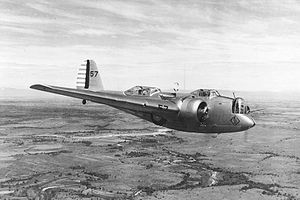The Martin B-10 was the first all-metal monoplane bomber to be regularly used by the United States Army Air Corps, entering service in June 1934.[2] It was also the first mass-produced bomber whose performance was superior to that of the Army’s pursuit aircraft of the time.[3]
 The B-10 began a revolution in bomber design. Its all-metal monoplane airframe, along with its features of closed cockpits, rotating gun turrets (almost simultaneously with the 1933 British Boulton & Paul Overstrand biplane bomber’s own enclosed nose-turret), retractable landing gear, internal bomb bay, and full engine cowlings, would become the standard for bomber designs worldwide for decades.[3] It made all existing bombers completely obsolete. Martin received the 1932 Collier Trophy for designing the XB-10.[4]
The B-10 began a revolution in bomber design. Its all-metal monoplane airframe, along with its features of closed cockpits, rotating gun turrets (almost simultaneously with the 1933 British Boulton & Paul Overstrand biplane bomber’s own enclosed nose-turret), retractable landing gear, internal bomb bay, and full engine cowlings, would become the standard for bomber designs worldwide for decades.[3] It made all existing bombers completely obsolete. Martin received the 1932 Collier Trophy for designing the XB-10.[4]
The creation of the B-10 came during an unusual moment of consternation for the company’s founder, Glenn Martin. Upset that early prototypes of his YB-10 were slower than its competition, he decided to take a vacation to refocus. Before he left, he told his engineers to move its bomb racks from under the plane’s wing to inside its fuselage.
The move inspired a series of key modifications, as Martin engineers expanded the wings to 70 feet in length while adding more powerful twin engines and enlarging the fuselage, inspiring the nickname “the Flying Whale.”
The moniker was deceptive. The B-10 was no whale in flight. It was the fastest bomber in the world, capable of outrunning nearly every pursuit plane in America’s arsenal. The aircraft’s internal bomb carriage, which was capable of carrying a 2,000-pound bomb load, and the addition of the world’s first enclosed rotating machine gun turret, an industry innovation, made it as formidable as it was fast.
Sources: Wikipedia, https://www.lockheedmartin.com/en-us/news/features/history/b-10.html
.
